On the banks of Zakhidnyi Buh River there are a lot of settlements with architectural monuments that attract the inquisitive travelers’ attention. These villages and towns have an interesting history, and the sights are its silent witnesses. One such village, which used to be a town, is Tadani. It is located 6 km from Kamianka-Buzka town. The river Horpynka flows through the village, and in its western part it flows into The Zakhidnyi Buh.
The first mention of the settlement dates back to 1440. According to the archival sources processed by V. Pshyk, we know that there was a castle in Tadani. Later, in 1563 in received the Magdeburg right. The history of Tadani as a town did not last long. Almost 100 years later, the settlement lost its status and became a modest villade. Here only architectural monuments remind of glorious times. Among them there are: a tower with a weathercock, which is the remains of lord Bortmanskyi’s palace (late 19th century) and two wooden temples: the church of St. Nicholas (1876) and the Polish catholic church.
Orthodox wooden temples are common in Lviv region, but the Catholic ones rarely were preserved.
In Tadani there is one of the oldest Polish Catholic churches in Ukraine. It stands on a quiet village street, near the old market square. The churchyard is hidden in the shade of trees on a small hill above the Horpynka River. It was built in 1734 at the expense of the Belz village owner, Cossack cavalry cornet Mykola Kots. The church has a very long and unusual name ‘Visit of Elithabeth to the Blessedd Virgin Mary and St. Thecla’. This is exactly how Archbishop Vatslav Sierakovskyi consecrated it in 1766, but people simply call it the Annunciation.
Externally the building has been damaged with time, and it required peoples’ assistance and restoration. The temple is three-log and is based on the stone foundations. In the center there is a square nave, to which the altar is adjoined, on the other side there is the narthex. You can notice straight strict lines with sharp corners in the temple appearance. The only part that has rounded shape is the altar, due to the cut corners. There is a gabled roof with sharp corners. During the temple construction the roof was covered with shingles. Unfortunately, in 1936 the church did not miss the so-called ‘tinning’. This phenomenon has become a tradition in many communities, including Tadani. Both wooden temples today in this village have tin roofs. The shingles on the church have remained only on the pediments of the main nave and the narthex.
The temple is unique for its well-preserved interior. As soon as you open the old wooden door, you will see a luxurious tempera mural of the late 18th century. On the blue background there are biblical stories, religious figures in gray, red and gold colors. At the top of the ceiling there is Eye of Providence; angels are stretching the roll with an inscription glorifying the Holy Trinity. On the walls there is a large image of the Virgin Mary and an image of untypical for this area Czech saint, John Nepomuk. Another interesting element of the interior is the cross beam, which separates the altar from the nave. It performs a constructive and decorative function. In the center there is the Jesus Crucification with the inscription ‘Jesus of Nazareth, King of the Jews’, and the year of the church construction ‘1734’.
The interior has miraculously been well-preserved. This building wasn’t always a temple. In the days of the collective farm, a barn was placed here, there grain was stored and processed, or as the locals say, flax was pounded. The carved altars were transported to the Catholic church in Bibrka. The temple got its role back in 1992. Since the village Catholic community is small, the services in the church are held only on major religious holidays. To do this, a priest from Kamianka-Buzka comes.
The church with a long name in Tadani is waiting to be noticed and helped to survive. Today there are very few such objects, so the wooden church of the 18th century is a real miracle that is necessary to be saved.
The areas along the Buh River are rich in monuments of folk architecture. Going to Kamianka-Buzka, you can plan a beautiful trip, full of interesting sacred sites: Batiatychi, Derniv, Sapizhanka, Kamianka-Buzka (former Kamianka-Strumylova), and, of course, remember about Tadani. Going to these lands, an inquisitive traveler will be able to curb their curiosity and get to know with the unique examples of wooden architecture of ‘Galician’ Volyn, as this piece of the ancient Belz principality of Volyn used to be called










